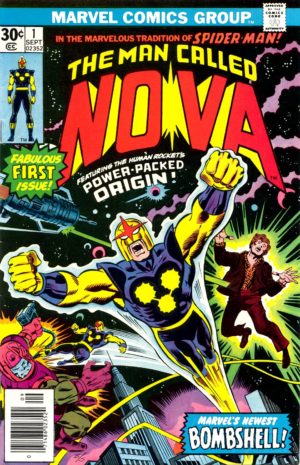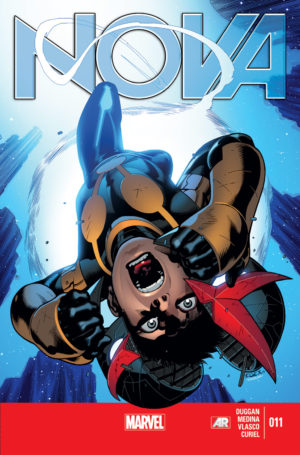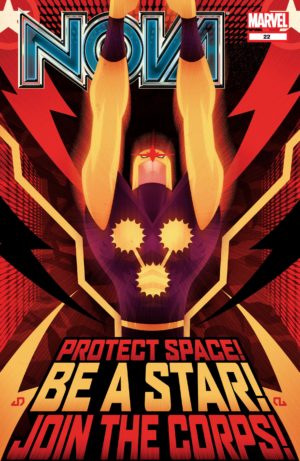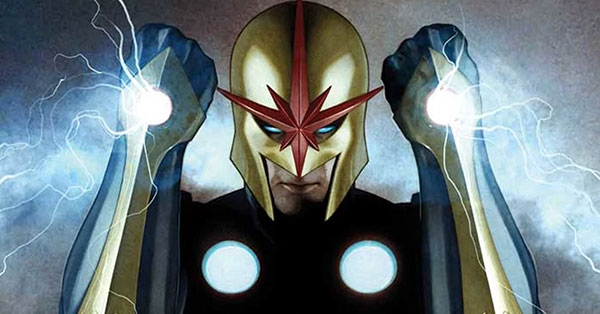Today I have an update to a character who Marvel has really transformed in the past decade – The Definitive Guide to Nova!
You might think I’m being tongue-in-cheek about “transformation” since we went from an older, established Nova to an inexperienced kid, but I’m talking about Marvel’s dedication to making Nova into a recognizable, franchise-able hero in a way they never had in his previous 30 years of publishing history.
Don’t need the full guide right now but curious about why I’m so bullish on Nova? Keep reading for a brief history, where to start reading, what Nova’s been up to in 2017, and how much of Nova’s now forty-year-long history Marvel has gathered into collected editions.
Who is Nova?
Nova was Marvel’s attempt at recreating the magic of Spider-Man with the mythos of Green Lantern.
Seriously – if you go back to read 1976’s Nova #1 it reads like half of a Spider-Man origin and half of a Green Lantern origin. A somewhat nerdy New York high school kid named Richard Rider finds himself infused with cosmic powers via the last member of a galactic peace-keeping core who died just as he reached Earth’s orbit.
Even if Marvel was lifting elements wholesale from two other mythologies, they were creating something new – a spunky, young cosmic hero who had to go from intergalactic adventures to trying to graduate high school.
It was charming, if not particularly significant, especially when compared to the monumental cosmic stories of the 70s in books like Warlock and Captain Marvel.
After his 70s series was shuttered (with a final plot thread wrapped in Fantastic Four), Nova all but disappears from the Marvel Universe for nearly a decade. He made his return when Marvel collected a number of existing teen heroes (plus a few new ones) into New Warriors, a sort of generic brand companion to New Mutants‘ transition into the self-directed X-Force. The title ran for years and over time felt more like a family than a team with a charter.
That created a problem for Nova, whose development was arrested in a sort of permanent post-adolescence while his teammates Firestar and Justice graduated to the main Avengers squad at the end of the 90s. Nova came back for a goofy reboot of New Warriors in 2006, but was spared the massacre that would kick off Civil War by being called into space by the Nova Corps.
This is where the transformation begins.
Marvel used Nova as the anchor of its first in a string of stellar cosmic events, Annihilation. While the event itself is composed of several disparate mini-series, there’s no doubt that Nova’s is the best of them and that he emerges from the event as a star and a whole new character. This is a decidedly adult Richard Rider, a weary soldier who can’t quite give up on the Corps that plucked him from an average life on Earth.
Rider graduates into his own series in 2007, which runs alongside the remainder of writers Abnett & Lanning’s incredible streak on cosmic Marvel. They finally leave the story behind with Thanos Imperative, which necessarily sacrifices Rider at its climax for peak drama at the end of 2010.
Thus, you can imagine the amount of fandom tooth-gnashing when two years later Marvel announced Nova would be back for Marvel Now, but it would be an all-new kid Nova named Sam Alexander discovering his powers for the first time. He got off to a rocky start, as virtually Marvel’s only title in Now to cycle through multiple writers without a reboot (both Jeph Loeb and Zeb Wells quickly departed for TV projects in succession, to be replaced by Jerry Duggan).
Despite the fan rage and writing merry-go-round, Sam Alexander as Nova somehow achieved a special kind of magic that the 1976 series never quite perfected.
He feels like a real kid, with dumb kid problems that he turns into dumb hero problems because he’s just a kid and he doesn’t know any better. Yet, none of the dumb problems ever feel trivial. Sam’s relationship with his absent father and beleaguered single mom is as palpable as his excitement at hanging out with other heroes and meeting cute space girls.
(I credit a huge amount of that success to the consistency of colorist David Curiel across 25 issues and multiple artists. The book had a signature, high-gloss palette.)
What really made Sam Alexander blossom is that Marvel wasn’t shy about letting him tangle with Marvel’s big league heroes and villains. Not only does he join the New Warriors, fight alongside Guardians of the Galaxy, and meet X-Men, but he flirts with joining the Avengers until finally getting drafted at the end of 2015. Reading Nova in Avengers is the wincing fun of any good coming-of-age tale. He comes off like a hot-headed braggart to Ms. Marvel and Spider-Man when we know he is really full of kindness and good intentions.
Having successfully relaunched the Nova franchise with a well-established new version of the character, Marvel does a smart thing for a chance and brings back Richard Rider. It might have been painful to do without Rider for over half a decade, but Marvel made the wait worth it, as Rider is now finally freed from the shackles of his arrested development with Sam Alexander to hold his spot as a teen Nova.
That is a transformation worth reading, and it consists of an entire decade of totally epic stories to enjoy.
Where to Start Reading Nova
Based on my breathless recap of Nova’s history, I’m sure you can already guess the three obvious starting points.

If you like 70s comics and want to get in on Richard Rider on the ground floor, start at the start with Nova Classic, Vol. 1. The three Classic trades have been out-of-stock for a while, so they’re a touch pricey. Unfortunately, the entire series is not on Marvel Unlimited.
While there is a lot of strong Nova material throughout New Warriors, it’s not concise and under-collected. If you’re not interested in the 70s material you should leap directly to Annihilation, as detailed in the updated Nova guide. Yes, you miss on understanding Nova’s transformation by skipping the earlier material, but the story is so good. This era is completely covered on Marvel Unlimited, which is way more affordable than getting all the hard copy books.
Finally, you can just start with Sam Alexander’s run as Nova in Nova, Vol. 1: Origin, which requires no foreknowledge. This is an especially good idea if you enjoy things like Ultimate Spider-Man or Robert Kirkman’s Invincible, which I’d say are two major touchtones for the series in two very different ways.
Nova in 2017
Our pair of Novas are having a very exciting 2017 – first, because they costarred in a seven-issue series together in the first half of this year! It was Rider’s first in-continuity appearance in seven years. It’s collected in full in Nova: Resurrection.
Just prior to the new series, Sam Alexander left the Avengers in the wake of Civil War II and has been in The Champions every month, starting with Vol. 1: Change the World. That’s currently his sole starring title, as it crosses over with his old Avengers team in “Worlds Collide.”
Meanwhile, Richard Rider has recently popped up in Guardians of the Galaxy #11 and #147. It will be interesting to see if he becomes a regular cast member, as he’s slightly redundant to Star-Lord on the team.
Current Collection Status
Nova is doing slightly better than the other 60s and 70s heroes we’ve seen when it comes to his collected standings thanks to the majority of his material being from 2006 and later.
| Year | Series | Total |
Collected |
Oversized |
| 149 issues |
124 (83.22%) |
56 (37.58%) |
||
| 1976 | Nova, Vol. 1 | 25 | 25 | 1 |
| 1989 | Vol. 2 | 18 | 0 | 0 |
| 1999 | Vol. 3 | 7 | 0 | 0 |
| 2006 | Annihilation: Nova | 4 | 4 | 4 |
| 2007 | Vol. 4 | 36 | 36 | 36 |
| 2010 | The Thanos Imperative | 8 | 8 | 8 |
| 2013 | Vol. 5 (Sam Alexander) | 33 | 33 | 7 |
| 2016 | Vol. 6 (Sam Alexander) | 11 | 11 | 0 |
| 2017 | Vol. 7 (Rider/Alexander) | 7 | 7 | 0 |
I felt a little torn while making this chart. Should I leave out his 70s guest appearances? Is it really fair to exclude all of New Warriors? Should it include more of Annihilation?
Ultimately, I decided against that. If every Collected Editions Standings included every major external story and guest appearance, none of these charts will ever get to 100%. What you see above is core Nova – the books you must read for the spine of his story. While there are moments at the end of Annihilation that fit that bill, the entire story doesn’t belong to Nova – as evidenced by it being skipped by the upcoming Nova by Abnett & Lanning: The Complete Collection Vol. 1.
How can we get from 83% to 100%? We’re only talking about 25 comic books – it really could happen in the span of a single collection if Marvel had the right motivation!
However, I think it’s more likely we see a Complete Collection of Nova’s 1989 series that simply skips issues #6-7, which tie in to the “Time and Time Again” crossover in New Warriors. Then, later, we can get a single “Nova and the New Warriors” Complete Collection of their twin 1999 series, which run a total of 18 issues between them.
Then we’d be 99% collected, likely waiting for a new New Warriors TPB line whenever their TV series finally finds a home.
I’m a little more intrigued by if we’re going to make progress on the oversize front anytime soon. Both Richard Rider’s 1976 series and Sam Alexander’s 2013 series are the perfect length for a mid-sized, digestible omnibus, and either would take Nova’s oversize status over the 50% mark.
Will it ever happen? If Nova’s prominence on the page at Marvel continues, I think it’s only a matter of time … and that says nothing for if James Gunn finally gives us a real onscreen Nova in Guardians of the Galaxy Volume 3.
So what are you waiting for? Visit the Guide to Nova and get to reading!
